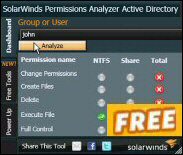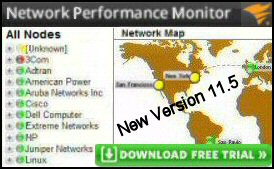PowerShell GCI -Filter Parameter
Filter is the most useful parameter to refine the output of PowerShell cmdlets such as Get-ChildItem (gci). I much prefer -Filter to -Include or -Exclude.
Topics for Get-ChildItem -Filter
- Example 1: List Only .dll Files with GCI -Filter
- Example 2: Compare -Filter with -Include
- PowerShell Commands which Use the -Filter Parameter
- PowerShell -Filter Command
♣
Example 1: List only .dll Files with GCI -Filter
Let us assume we want a list of the dynamic link library (.dll) files.
Clear-Host
$Files = "$Env:windir\System32"
Get-ChildItem $Files -Filter *.dll
Note 1: $Env:windir is a built-in variable that usually corresponds to:
C: \Windows.
Note 2: You could research more parameters with Get-Help gci. For example, you could append -Force to search hidden directories, and -ErrorAction to suppress messages.
Recommended: Solarwinds’ Permissions Analyzer – Free Active Directory Tool
I like the Permissions Monitor because it enables me to see WHO has permissions to do WHAT at a glance. When you launch this tool it analyzes a users effective NTFS permissions for a specific file or folder, and takes into account network share access, then displays the results in a nifty desktop dashboard!
Think of all the frustration that this free SolarWinds utility saves when you are troubleshooting authorization problems for user’s access to a resource. Give this permissions monitor a try – it’s free!
Download SolarWinds’ Free Permissions Analyser – Active Directory Tool
Example 2: Compare -Filter with -Include
I would always choose -Filter rather than -Include. Filtering is faster, and the results are more predictable.
Let us try a head-to-head speed test between -Filter and -Include. Here are the tasks for the comparison:
- Retrieve the .dll files with Get-ChildItem.
- Time the script in TotalMilliseconds with Measure-Command
- Check it retrieves the same number of files as Trial B.
Trial A -Filter Speed
# PowerShell GCI -Filter speed experiment
Clear-Host
[Decimal]$Timing = (Measure-Command{
$Files = "$env:windir\System32"
$Result = Get-ChildItem $Files -Filter *.dll -Recurse -EA SilentlyContinue
}).TotalMilliseconds
$Timing =[math]::round($Timing)
Write-Host "TotalMilliseconds" $Timing
Write-Host "File count:" $Result.count
Results
TotalMilliseconds 724
File count: 3685
Note 3: EA means ErrorAction. You could also add the -Force parameter to both trials.
Note 4: I could not find any benefit from adding a ‘\’ or * to the path:
$Files = "$env:windir\System32\" made no difference, and \* was slower.
Trial B -Include Speed
# PowerShell GCI -Include speed experiment
Clear-Host
$Timing = (Measure-Command{
$Files = "$env:windir\System32"
$Result = Get-ChildItem $Files -Include *.dll -Recurse -EA SilentlyContinue
}).TotalMilliseconds
$Timing =[math]::round($Timing)
Write-Host "TotalMilliseconds" $Timing
Write-Host "File count:" $Result.count
Results
TotalMilliseconds 5884
File count: 3685
Note 5: It ‘feels’ longer when you run the -Include version; a fact confirmed by TotalMilliseconds.
Note 6: I employed [math]::round just to make it easier to read.
See more on PowerShell’s Measure-Command
Guy Recommends: A Free Trial of the Network Performance Monitor (NPM) v11.5
v11.5
SolarWinds’ Network Performance Monitor will help you discover what’s happening on your network. This utility will also guide you through troubleshooting; the dashboard will indicate whether the root cause is a broken link, faulty equipment or resource overload.
What I like best is the way NPM suggests solutions to network problems. Its also has the ability to monitor the health of individual VMware virtual machines. If you are interested in troubleshooting, and creating network maps, then I recommend that you try NPM now.
Download a free trial of Solarwinds’ Network Performance Monitor
Research PowerShell Commands which Use the -Filter Parameter
Here is script to list cmdlets beginning with ‘Get’ which contain the -Filter parameter; feel free to modify for your own research.
Get-Command | Where { $_.parameters.keys -Contains "Filter" -And $_.Verb -Match "Get"}
Note 7: The big benefit of PowerShell’s -Filter parameter is that the provider sifts the object as it retrieves them, which is much faster than obtaining the whole list, and only then including some items or excluding others.
Here is function I created to extend what Get-ChildItem can achieve. Get-File function.
One Disadvantage of -Filter
You can only sift using one value with -Filter, whereas -Include can accept multiple values, for example ".dll, *.exe"
Try Other Parameters
# Research PowerShell Get-Childitem Parameters
Get-Help Get-Childitem -Full
Note 8: This reveals parameters such as -Include and -Exclude.
Compare with PowerShell’s -Include parameter »
Summary of Get-ChildItem -Filter
PowerShell’s filter parameter is easy to use; it is also much faster than alternatives such as GCI -Include or -Exclude.
If you like this page then please share it with your friends
See more Microsoft PowerShell file tutorials:
• PowerShell Home • PowerShell Backup Copy-Item • PowerShell Files • Free Import CSVDE Tool
• PowerShell Registry • Get-Credential • PowerShell ItemProperty • PowerShell -Recurse
• PowerShell Get-ChildItem • PowerShell -Filter • Free Permissions Analyzer • Compare-Object
Please email me if you have a better example script. Also please report any factual mistakes, grammatical errors or broken links, I will be happy to correct the fault.

